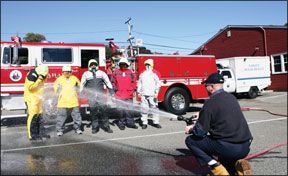
288
All foul-weather gear is not created equal. Before plopping down hundreds of dollars for a mid-range jacket and bibbed trousers, it is a good idea to give the gear a thorough inspection, paying particular attention to a few key features.
That is exactly what Practical Sailor testers did with the sets of foul-weather gear we received for testing from seven manufacturers.
A quality set of foul-weather gear must, above all, be warm, dry, and comfortable. The bibs should have wide, easily adjustable shoulder straps that don’t cut into the wearer. The brimmed hood should be a visible color and have reflective material attached. Its peak should be semi-rigid to deflect water, and it should have a drawstring to cinch it around the wearer’s face. The hood should be easily deployed, stowed, and secured. The jacket should be breathable, have integrated vents, and be water-tight at the neck and wrists. It should have adequate reflective material in places that could be visible in a man-overboard situation—like the hood, shoulders, and the top of the back.
The trousers should feature abrasion padding on high-stress areas like the knees and seat, and should be water-tight at the ankles. Zippers should be high-quality, durable, and big enough to grasp with chilled fingers. The garments must have shoulder swing room, and while they should be form-fitting, they should still be able to accommodate a fleece or other midlayer beneath. The material must be windproof and waterproof, yet breathable.
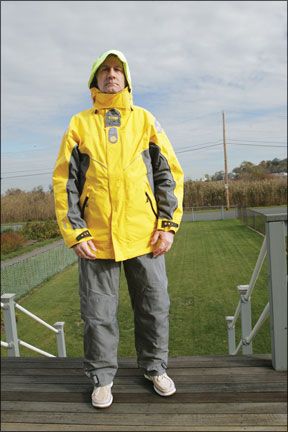
288
Other areas of concern include the garment’s ease of donning and doffing; pocket design and location; loops for attaching knives; special pouches for handheld electronics; and fast-adjust buckles on trouser shoulder straps.
What We Tested
Each foul-weather set we tested consisted of a jacket and a pair of bib trousers suitable for coastal cruising and light offshore sailing. All test suits were priced under $500 for the full kit, which by industry standards is middle grade—the next step can easily reach $1,000. The participating manufacturers were: Gill International, Gul, Helly Hansen, Henri Lloyd, Ronstan, Slam, and Third Reef from West Marine. The Gill, Helly, Gul, and West Marine suits are tailored for men, while the others are unisex.
Gear-maker Atlantis recently rejoined the ranks of foulie makers, but at test time, its new product line was not yet fully developed. Products were requested from Musto but were not provided. We hope to test gear from both of these manufacturers for a future update.
All of the test jackets had fluorescent yellow hoods for high visibility in all conditions, and all offered high-cut collars for good face protection. However, it was clear from the test’s outset that some were of higher-quality materials and had superior workmanship. These differences were evident in the wind- and water-resistance tests: The higher-quality garments performed nearer to “windproof” and “waterproof,” while the others were merely resistant to the elements. We also found—as we did in the boat shoes tests in 2007—that there is no standard for sizing. All test products were size men’s large, but some were a bit snug and others were too loose.

288
All seven manufacturers that participated produce quality foul-weather gear, some excelling in areas where others apparently focus less attention, and vice versa.
Gill
The Key West OS5J jacket and OS5T bib trousers are evidence that Gill has mastered the art of crafting high-performance foul-weather gear.
Testers found only a few things to complain about on the Gill gear: It was a bit roomy (but offered plenty of room for a fleece or other midlayer to be worn beneath it), and the trouser zipper is not a two-way zipper. Also the jacket slash pockets lack the protection of a flap that cargo pockets typically have. Gill claims that the zipper is waterproof, but our experience with “waterproof zippers” has left us skeptical that they will keep pocket contents totally dry.
Other than that nitpicking, the Gill gear gets four stars—or three dots, according to Gill’s rating system. (Three dots mean the gear is for coastal and offshore use with high breathability and high durability.)
The Gill bibs are rugged with thick shoulder straps fitted with heavy-duty velcro that can be adjusted in seconds—no need to fuss with buckles or snaps. They have a reinforced seat and knees for abrasion protection. The jacket’s hood and its beefy zippers function easily, even with cold hands. Its taped seams and adjustable cuffs with inner seals successfully kept water out during our field tests. The jacket has plenty of pockets, including zippered internal pockets and fleece-lined handwarmer pockets. Although the trousers lack a waist adjustment, they do have fleece-lined pockets and a water-tight cargo pocket.
The Key West jacket is available in red, yellow, silver, and black, while the bibs come in only gray. The jacket has Reflexite reflective patches at the shoulder/arm seam and at the center of the chest. Both the jacket and trouser are available in women’s fit. (Look for a review of women’s foulie gear in an upcoming issue.)

288
Bottom Line: The Key West kit exceeds testers’ standards for construction and design quality, securing its rating as the PS Best Choice for men’s foul-weather gear in this price range.
Gul International
Britain-based Gul International, best known for its innovations in the world of surfing gear, also produces sailing gear that is anything but traditional. The Gul Newport Storm coastal jacket and coastal hi-fit trousers employ the same weather-protection strategy adopted long ago by mountain climbers: layer, layer, layer. The coastal kit’s two-layer GCX2 EVO material is featherweight and more comfortable than your favorite pajamas.
Despite its lightness, the material weathered abrasion and heavy spray favorably in our tests, but we’re curious to see how it will stand up over time. Heat-taped seams kept our tester dry during testing, and chest vents improved breathability. The Newport wasn’t completely weatherproof though, as our testers noted that wind penetrated the material during the fan test.
Despite Gul’s layering philosophy, testers found the Newport coastal products a bit too snug to allow for such layering. Our testers—average size for American men, about 5 feet, 11 inches tall, and weighing about 180-200 pounds—noted during tests that the UK-made Gul men’s size large had little room for a fleece or heavy sweater underneath. According to Gul, sizing was intentionally scaled down this year to produce a more narrow fit and reduce the amount of windage from loose material flapping in the wind. Gul does offer the jacket in sizes men’s small to XXL.
The jacket sports prismatic reflective strips on the chest and high on the shoulders. It also offers a notably comfortable collar and plenty of pocket space with quick-dry hand-warmer pockets and quick-draining cargo pockets. The trousers also have hand-warmer pockets and a quick-draining pocket on the thigh.
Like the Gill bibs, these have rugged, elasticized suspenders for easy adjusting. But the Gul bibs have a storm-flap over the two-way zipper where the Gill doesn’t. Taffeta-lined, the trousers are reinforced at the seat and from the knees to the ankle for extra abrasion resistance.

288
The Newport jacket comes in black, red, and yellow, and the trousers are available in yellow and black.
Bottom Line: This lightweight, comfortable, and seemingly rugged foulie set impressed testers. The main thing holding it out of Best Choice-contention was its performance in the wind test.
Helly Hansen
Helly Hansen—well known for its fashionable ski and water-sports apparel—continues to crank out quality foul-weather gear like the new men’s Fjord jacket and new Fjord hi-fit trousers we tested, but some of the frills seem a bit over the top. For example, the AquaPac—a clear, watertight, plastic pouch sewn onto the New Fjord jacket sleeve—is meant as a protective pocket for your cell phone or other small electronic device. (See “A Closer Look,” above.) To test the functionality of the AquaPac, we inserted a very slim flip-phone. Testers had difficulty removing it with bare hands. Extracting the phone in an emergency or with gloved hands likely would be nearly impossible. Perhaps another fashion-over-form feature: Neither the jacket nor the trousers have anti-abrasion patches.
The suit, made from HellyTech fabric, fits the American man’s frame well, just loose enough for a midlayer.
Testers noted that the Helly zippers were a bit undersized and the jacket’s wrist closures left room for improvement. The closures include circular velcro patches to secure the wrist tab at its loosest setting. After opening and closing the tabs 200 times, testers found they lost much of their ability to adhere, leaving the wearer with flapping strips of material at the wrist.

288
The jacket has more reflective surfaces, overall, than other test jackets thanks to its reflective piping that runs along the chest, arms, and back. We prefer patches to piping, but every bit helps, and the jacket also has reflective patches on the forearms and shoulders.
Bottom Line: Despite its fastener issues, the Helly Hansen is high-quality foul-weather gear. We’d like to see anti-abrasion patches added.
Henri Lloyd
Henri Lloyd manufactures an array of sailing gear, including many styles of foul-weather gear for men and women. We tested the new for 2008 TP2 Biscay Jacket and TP2 Coastal hi-fit trousers.
According to the maker, the TP2 fabric technology uses a moisture transfer that helps reduce condensation on the inside, keeping the wearer dryer during high activity. Testers found the TP2 fabric to be lightweight and comfortable.
The Henri Lloyd size large suit was too roomy for an average man, but it rated Excellent in most of the performance categories.
Like the Gill wear, the Henri Lloyd kit has high-quality bungees and heavy-duty zippers. But like the Helly gear, the jacket has the circular velcro wrist closures that showed a tendency to wear out during testing. The large zippers were easy to handle, even with gloved hands.
The jacket has reflective patches at the neck and on the shoulders, as well as a storm flap over the two-way zipper. It is available in navy, gray, and red. We would highly recommend the red jacket. In a man-overboard situation, crew waving gray- or navy-clad arms at the water’s surface would be nearly impossible to spot, and that fluorescent hood would only work if deployed.
The taffeta-lined trousers come in the same colors as the jacket and have adequate pockets, a two-way zipper, and reinforced knees, shins, and seat.
Brand new at presstime, the Biscay gear had not yet been posted on any online U.S. chandleries. The price given in the Value Guide ($375 for the set) is the manufacturer’s suggested retail price. The kit will be available through www.landfallnav.com, www.apsltd.com, and West Marine.
Bottom Line: The Biscay gear was in close contention with the Gill kit, but it comes with wear-prone wrist closures and a slightly bigger price tag, so the advantage went to Gill.
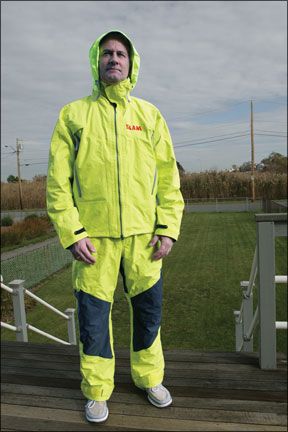
288
Ronstan
Ronstan, an Australian company with its U.S. office in Rhode Island, offers foul-weather gear for inshore, coastal, and offshore sailors. The Heavy-duty Coastal Breathable jacket and trousers (CL161 and CL152) that we tested are made of Ronstan’s breathable R-Tech 5 nylon fabric. The R-Tech 5 didn’t offer as complete protection from the elements during our tests as the top performers, but protection was adequate. Testers noted that during the fan test, wind easily made its way in at the neck and waist.
Like the Henri Lloyd gear, the Ronstan men’s large offers ample room for mid-layer clothes, perhaps too much. The jacket has a polyester lining, taped seams, and a fleece-lined collar. It also has the preferred two-way zipper with storm flap and fleece-lined pockets.
Unlike most of the other test products, the Ronstan trousers have a zipper only at the fly, rather than a full frontal zipper. This removes the need for a two-way zipper, but makes donning more difficult. Also, unlike the no-fuss Gill bibs, the elastic Ronstan suspenders attach and adjust via plastic buckles.
The trousers are polyester lined and have mesh lining at the ankles for quick draining. They have four hip pockets and one cargo pocket on the right thigh. Reinforced abrasion-resistant fabric covers the knees and the seat.
The Ronstan has good safety features with reflective piping along the chest and arms and reflective patches on the chest and shoulders.
The Coastal Jacket comes in grey or red, sizes XXS to XXL, while the trousers come in grey in the same sizes.
Bottom Line: The Ronstan gear was not at the top of the class, but at $270 for the full kit, it offers adequate protection and is a bargain for coastal cruisers with tight purse strings. It gets the PS Budget Buy.
Slam
The Italy-based Slam markets predominantly to the racing crowd, and this was obvious in the gear we tested from Slam’s Evolution line: the 2007 Russell Coutts-inspired Evolution Extreme Sailing Jacket and Long Johns. The Euro-styled suit is made from lightweight, breathable fabric.
The suit is ideal for the go-fast crowd, but it lacks features essential to the cruiser. The jacket has two zippered and fleece-lined slash pockets, which aren’t the most trustworthy for electronics like a handheld GPS or VHF, nor are they adequate for warming chilled hands, in our opinion. The gear has heat-taped seams, which offer good protection from wind and water.
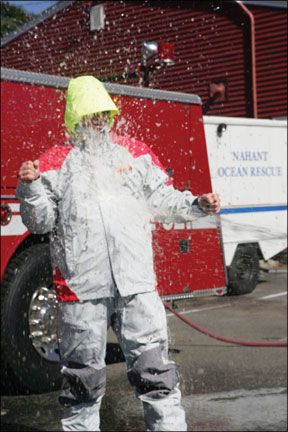
288
Like the Gul gear, testers found the Slam suit a bit snug and the zippers a bit undersized for operation with cold or gloved hands. The Slam jumpsuit does have plenty of abrasion-resistant material on the knees and stood up well in the wind resistance tests. But testers found that water leaked in at the jacket’s neck closure. Both the jacket and trousers are a bright yellow-green for good visibility, but the jacket has only one small patch of reflective material on the hood.
The jumpsuit-style long-johns are more difficult to get on and off quickly than those with suspenders. However, some people may prefer these as they are more weatherproof and the elasticized waistband reduces weight placed on the shoulders, Slam reports.
The Slam garments we tested were the 2007 designs, and according to Slam, suspenders-style trousers will be offered in the 2008 lineup, along with the long johns.
Testers had the opportunity to review a prototype of Slam’s upcoming Russell Coutts Evolution jacket (an update to the one in this test). We liked its pockets and unique cell-phone pocket on the interior. Overall impressions were the same as for the version we tested. Since it was still a prototype, it was not formally rated.
Bottom Line: The 2007 Slam Evolution gear is well designed and constructed, but featurewise, it is better suited for racing than cruising. Slam does offer more cruiser-friendly foulies, but their cost exceeds the price-point set for this test. We look forward to seeing the 2008 designs.
West Marine
Boating retail giant West Marine has its own brand of foul-weather gear. The Third Reef jacket and trousers are made of two-layer Oxford nylon with breathable polyurethane backing and fully taped seams. This kit performed on-par with those kits in its price range, but it didn’t offer complete protection from wind and water.
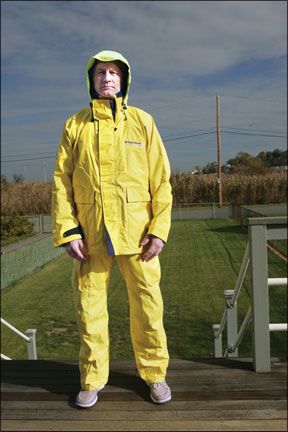
288
Both the jacket and trousers are taffeta-lined with mesh at the wrists, hem, and ankles for drainage. The Third Reef gear fit our testers well, offering just enough room for underlayers. The trousers have fuss-free elastic suspenders, with no buckles or clips to worry with for adjustment. They have a full-frontal zipper, but it is not a two-way and it’s small. The jacket, however, does have a two-way zipper and has cargo and fleece-lined handwarmer pockets as well as interior cell-phone and zippered security pockets. The jacket’s high collar is lined with a soft mesh for breathability, a nice feature.
Testers were disappointed to see that the Third Reef gear completely lacked reflective material—no patches, no piping.
Both the jacket and trousers come in yellow or red, sizes small to XXL. West Marine does offer women’s fit foulie gear, and its Explorer line has more cruiser-friendly features. Look for these in a future review.
Bottom Line: For an entry-level kit, the Third Reef gear does the job, but the Ronstan gear does it better and is worth the higher price.
Conclusion
All of the top performers in this test can be categorized as high-quality. Testers had a tough time narrowing the field. But in the end, across-the-board excellence and an affordable price earned the Gill Key West gear the PS Best Choice. Performance- and pricewise, the sets from Gul, Helly Hansen, and Henri Lloyd were neck-and-neck. All provide Good or better wind and water protection, and offer unique features.
If you’re cash-strapped, go for the Ronstan kit, our Budget Buy.
Stay tuned to see how these players and others measure up in the women’s foul-weather gear tests.








































